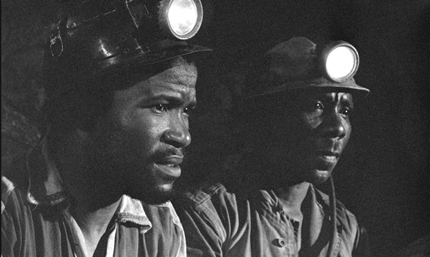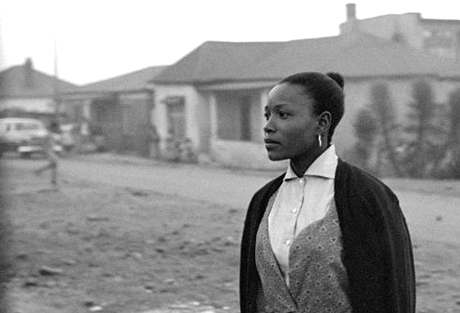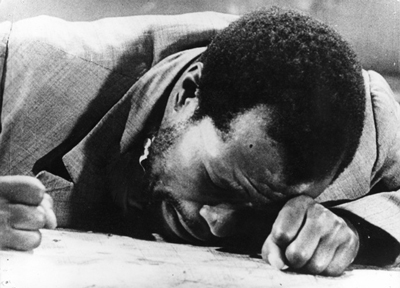|
|
Reviewed by Glenn Erickson
In 2012 The Milestone Collection released one of their very best disc offerings, On the Bowery: The Films of Lionel Rogosin, Volume 1. The astonishing On the Bowery is said to have inspired a wave of independent filmmaking, giving encouragement to artists like John Cassavetes. It's a show not to be missed, as every other shot shouts, "how did he do that?"

But that movie was actually Lionel Rogosin's warm up, his learning project to gain the self-confidence to move on the movie he really wanted to make. Milestone presents it and several other films on Come Back, Africa - The Films of Lionel Rogosin, Volume 2. Almost immediately Rogosin began visiting South Africa, to figure out how he could film a drama exposing the evils of apartheid, the segregationist policy made official in 1948 that reduced the rights of, and government services available to minorities, especially the majority black population. Nobody had dared document the reality of apartheid from the inside; Rogosin's intention was to film an entire feature surreptitiously, under the noses of the Afrikaner minority South African government.
The thorough making-of documentary on the disc takes the viewer through the process step by step, showing how Rogosin made contact with members of the African National Congress (ANC; Nelson Mandela's illegal opposition party) and white dissidents willing to risk their necks to help with his film, and even appear in it. Meanwhile, Rogosin characterized his proposed film to the Government by calling it a travelogue, or an industrial film. One thing he knew for sure is that he'd never be able to return to South Africa. But the topic was too important to resist. Come Back Africa was filmed in a black township called Sophiatown, which was already being razed and its black population 'relocated' to make room for a new all-white suburb.

Come Back Africa is the story of Zachariah (Zacharia Mgabi), a 'Zuluman' who has come to Johannesburg to make money to better support his wife. He first tries a gold mine, but the wages aren't enough for him to live on and they want him to sign a contract that won't even allow him to leave the premises to see his wife. He then becomes a houseboy to a bitterly bigoted white housewife, and is soon fired for mistakes and what she terms general insolence. She also insists on renaming him 'Jack' for her own convenience. He falls in with some easy-going fellows but leaves when a woman at a party seems intent on seducing him. One rather disreputable new acquaintance has a knack for getting them jobs. The boss at a garage keeps them on even after they take a joy ride in a customer's car, but fires them after he hears dissident ANC talk -- he doesn't like Communists. Zacharia's wife Vinah (Vinah Makeba) shows up and they stay with an aunt while he continues to look for a good job. She's fled their country home because without Zacharia around, her cattle has been stolen. Zacharia's story goes from bad to worse when his travel permit expires and he's suddenly an illegal in his own country. If he goes to jail, Vinah will be as unprotected here as she was in the country.
The film was written by Lionel Rogosin and Lewis N'Kosi, a writer for the progressive South African magazine for blacks, Drum. The acting is basic but never primitive. Zacharia has an honest but resolute face. He's a bit of a bumpkin at first and cannot restrain himself from playing with his lady employer's clothing, like a child. If he isn't held up for his money, it's surely because of his imposing size. Rogosin fills his picture with real events caught on the fly on Sophiatown's main street -- wedding processions, kids playing, street musicians that range from tribal to imitations of American Rock 'n' Roll. But the streets are mean -- thugs attack a successful kid music group and steal their money. To our astonishment, MGM's Fiend Without A Face is playing at a small theater. Is Rogosin alluding to apartheid as the Fiend? The most telling street scene shows a circle of older men doing a tribal dance, but in raggedy work clothes instead of tribal finery. They're trying to retain their tribal identity; the government wants to transform them into a passive source of cheap labor.

A meeting of pro-ANC folk (a "shebeen?") segues from drinking to political discussion that sounds identical to black power rhetoric in the U.S. from half a decade later -- talk of the evil of the paternal, patronizing white masters. Another fellow starts a debate about the special persecution held out for mixed-race people. The government is fanatical about separatism. At a couple of these 'meetings' a female guest stands and sings. She's terrific, and we soon discover that she's Miriam Makeba, at the time well known in South Africa but held down by white record producers who give her $50 per recording and send her on her way.
As explained in the fascinating making-of documentary An American in Sophiatown (64 min.), Miriam Makeba wasn't exactly kind to Rogosin. He was so impressed by her talent that he pulled strings to get her an unheard-of exit visa. She garnered instant interest from the recording community. Not much later she was 'adopted' by Harry Belafonte and Marlon Brando (?) and claiming that Rogosin was an unkind man. She also refused to promote the movie. Was she protecting relatives back home? South Africa was of course furious to find that it had been tricked; Rogosin says that the Afrikaners never believed a white American would betray his race in this way.
Not to defend Ms. Makeba, but the docu does hint that Rogosin may have left some people in the lurch. We hear nothing about whether his actors left behind had difficulties. But cameraman Emil Knebel stayed on to take pick-up shots as needed in the New York editing room of legendary Carl Lerner. Lionel openly publicized his secret exposé without telling Knebel, who was arrested and then booted from the country. This making-of docu was directed by Michael Rogosin and Lloyd Ross.

The second Blu-ray in Volume 2 contains a rather arty film with an intimate view of black consciousness, Black Roots (1970, 63 min.). An hour long, it's a casual look at several black musicians, mostly folk-oriented, as they play their music and tell stories from their backgrounds. Interspersed with shots of ordinary black faces in the city and accompanied by occasional well-known pop tunes (Ray Charles, James Brown, Sly and the Family Stone), the stories are the most interesting content. One singer talks about not realizing how bitterly racist America is until he went to Portugal and saw blacks being treated with equal decency. One of the best speakers is a Civil Rights Activist, Wende Smith. She makes a story about her mother not being able to bake rolls seem like a beginning essay in racial inequality. Other stories are about violence and taking a stand. Alan Lomax organized the music.
Black Roots is like a museum exhibit that needs further explanation, which Milestone provides in 2013's Bitter Sweet Stories (27 min.). At least this follow-up film identifies the music and the musicians. Only here will non-music fans learn the names Jim Collier and Reverend KIrkpatrick, who played Carnegie Hall together, and discover that speaker Florence Kennedy was also a respected scholar and the first black woman to attend Columbia Law School. Lionel's son Michael directed.
Finishing up is Have you seen Drum lately? (1989, 74 minutes), an exciting video documentary about the South African magazine whose staff provided Come Back, Africa with writing and assistance in the Sophiatown underground. The Wiki article is a very good read, describing Drum as "the first black lifestyle magazine in Africa chiefly notable for its early 1950s and 1960s reportage of township life under apartheid." Using the magazine's photo file we gain access to a group of affluent and influential blacks living large and driving sports cars. The '50s in South Africa look like a lot of fun until the film's focus turns almost completely to the experience in the townships and the rise of the ANC. Although some other leaders are given stronger emphasis at this time the young Nelson Mandela makes a number of appearances. Liquor and then dancing are prohibited in the townships and the pass laws are imposed on women as well. Floggings, terrible prison sentences are the norm for political crimes, where opposing parties are tried as Communists. A judge who favors the laws of Nazi Germany actually lets the ANC leaders go at one point. The documentary is by Jurgen Shaderberg.
The Milestone Cinematheque's Blu-ray of Come Back, Africa - The Films of Lionel Rogosin, Volume 2 is a beautifully transferred eye-opener and the equal of volume one; we're compelled to imagine the nerve of Rogosin and his confederates filming such a sophisticated movie under such conditions. Perhaps the Africaners were indeed overly trusting of a white New Yorker. I would think that the next cinematic genius claiming he wanted to film butterflies would get the third degree.
Martin Scorsese contributes a two-minute introduction to the main film; on my one Blu-ray player this piece drifted out of synch. Also included is a 19-minute interview with Lionel Rogosin about Come Back, Africa from 1978. The main features Come Back, Africa and Black Roots do have English subtitles, that are only accessible through the menus. This is a big plus, although the other additional supporting docus are not subbed.
On a scale of Excellent, Good, Fair, and Poor,
Come Back, Africa - The Films of Lionel Rogosin, Volume 2 Blu-ray rates:
Movies: Excellent
Video: Excellent
Sound: Very Good
Supplements: intro Martin Scorsese, additional interview with Lionel Rogosin
Deaf and Hearing-impaired Friendly?
YES on two main features only; Subtitles: English accessible in menu.
Packaging: Two Blu-ray discs in keep case
Reviewed: February 18, 2014

Text © Copyright 2014 Glenn Erickson
See more exclusive reviews on the Savant Main Page.
The version of this review on the Savant main site has additional images, footnotes and credits information, and may be updated and annotated with reader input and graphics.
Return to Top of Page
|

